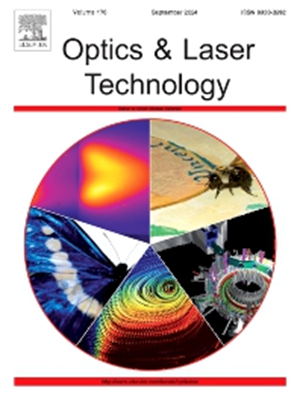A mathematical model for ultrafast laser processing of the slight curvature surface
IF 4.6
2区 物理与天体物理
Q1 OPTICS
引用次数: 0
Abstract
The precise control of the amount of material removal in the ultrafast laser ablation process is hindered by a number of factors, rendering it unable to meet the demand for accurate processing of complex surfaces. It is essential to employ an effective simulation method to predict the outcomes of ablation processing, thereby facilitating subsequent optimisation of parameters and precision process research. In this paper, a pulse-by-pulse mathematical model is presented for simulating the ultrafast laser ablation process for general materials. The mathematical model of the focused Gaussian beam considers the influences of key parameters, including the propagation direction of the beam, the position of the focal point, and the laser fluence, among others. The evolution process of etching materials was analysed, and the material ablation rate under different beam states was calculated. The actual processing was then simulated pulse by pulse using the grid division method. The model is straightforward and accessible, with parameters determined through a limited number of calibration experiments. The simulation accuracy for points, lines, and planes is approximately 0.9, with a mean simulation time of 1.3 s for a single pulse. The ablation model is well-suited for simulating complex curved surfaces, offering a valuable tool for precise ultra-fast laser machining.
微曲率表面超快激光加工数学模型
超快激光烧蚀过程中材料去除量的精确控制受到多种因素的阻碍,无法满足复杂表面精确加工的需求。必须采用有效的模拟方法来预测烧蚀加工的结果,从而促进后续的参数优化和精密加工研究。本文提出了一种逐脉冲数学模型,用于模拟一般材料的超快激光烧蚀过程。聚焦高斯光束数学模型考虑了光束传播方向、焦点位置和激光通量等关键参数的影响。分析了蚀刻材料的演变过程,并计算了不同光束状态下的材料烧蚀率。然后使用网格划分法逐个脉冲模拟实际加工过程。该模型简单明了,参数通过有限的校准实验确定。点、线和平面的模拟精度约为 0.9,单脉冲的平均模拟时间为 1.3 秒。该烧蚀模型非常适合模拟复杂的曲面,为精确的超快激光加工提供了宝贵的工具。
本文章由计算机程序翻译,如有差异,请以英文原文为准。
求助全文
约1分钟内获得全文
求助全文
来源期刊
CiteScore
8.50
自引率
10.00%
发文量
1060
审稿时长
3.4 months
期刊介绍:
Optics & Laser Technology aims to provide a vehicle for the publication of a broad range of high quality research and review papers in those fields of scientific and engineering research appertaining to the development and application of the technology of optics and lasers. Papers describing original work in these areas are submitted to rigorous refereeing prior to acceptance for publication.
The scope of Optics & Laser Technology encompasses, but is not restricted to, the following areas:
•development in all types of lasers
•developments in optoelectronic devices and photonics
•developments in new photonics and optical concepts
•developments in conventional optics, optical instruments and components
•techniques of optical metrology, including interferometry and optical fibre sensors
•LIDAR and other non-contact optical measurement techniques, including optical methods in heat and fluid flow
•applications of lasers to materials processing, optical NDT display (including holography) and optical communication
•research and development in the field of laser safety including studies of hazards resulting from the applications of lasers (laser safety, hazards of laser fume)
•developments in optical computing and optical information processing
•developments in new optical materials
•developments in new optical characterization methods and techniques
•developments in quantum optics
•developments in light assisted micro and nanofabrication methods and techniques
•developments in nanophotonics and biophotonics
•developments in imaging processing and systems

 求助内容:
求助内容: 应助结果提醒方式:
应助结果提醒方式:


